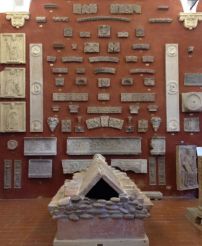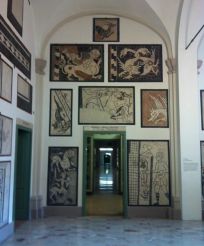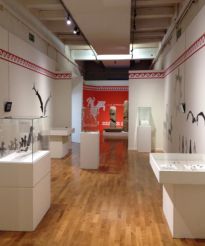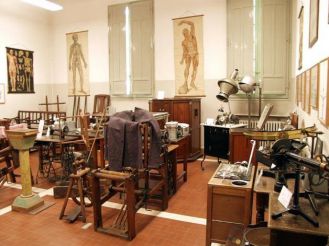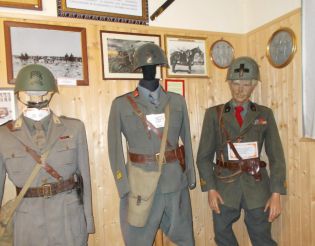Civic Museums, Reggio Emilia
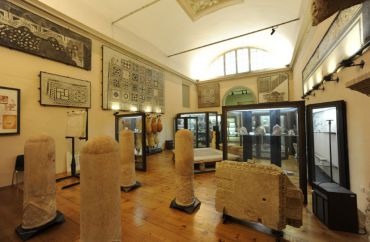
Civic Museums (Palazzo dei Musei) in Reggio Emilia contains a whole network of civilian museums of the city. Instead of a single ordinary museum, typical for small towns, a number of institutions that are united under a local municipality were housed in the huge building of the former monastery. Here you can see the richest historical, archaeological, natural collections and a collection of works of art.
History of the museum
The reference point is 1256, when thanks to the permission of Bishop Guglielmo Fogliani, the Franciscan monks settled in the former imperial palace in the center of the city. It has already been used by bishops since 1195. Gradually, by the end of the 13th century, the palazzo was transformed into a monastery. The dwelling of monks grew and developed. The largest works on alteration were carried out at the beginning of the 18th century. During the invasion of Napoleon Bonaparte the monastery fell into decay, barracks and stables were built on its premises.
After the liberation of the city in 1815, the palace was restored, placing a law college and the Royal School of Physics and Chemistry here. This gave impetus to the founding of the museum and its first collection in 1830, which became the private collection of Lazzaro Spallanzani. In 1862-1870, the archaeological exhibition Gaetano Chierici was founded, supplemented in 1875. Significant replenishment of the museum's exposition took place at the end of the 20th century.
In 2005, a cardinal reconstruction was carried out, which made it possible to make full use of the vast premises of the former palace for museum needs.
Exposition of the museum
The entire museum collection is very, very large and is located on three floors of the palace. The variety of exhibits can easily be grouped into 4 separate sections, each of which is quite interesting and worthy of special attention.
- Archaeology. Its founder was the priest Gaetano Chierici, who in 1870 opened the Museum of the History of the Motherland. The latter became the core of the future archaeological collection. Its main part includes finds that are directly related to the region, the second part – items from other regions of Italy. In 1975, new collections of proto-history were added, supplemented in 1991-1992. They include items from excavation areas in the province, which have been actively carried out since the 1940s. And since June 2018, this part of the collection is not available due to the repair of the floor. In 1997-1998, an exhibition was created, demonstrating the Roman period in the history of Reggio Emilia. It includes a numismatic collection and findings of the early Christian period.
- Natural history. The history of the museum began from this part. In 1799 the city authorities acquired the naturalistic collection of the scientist Lazzaro Spallanzani, exhibited in 1830. After the opening of the museum, the exposition grew thanks to the new zoological and botanical collections of the 19th century. Later, in the 20th century, they continued to increase. At the end of the 19th century, an anatomical collection was formed, with a special emphasis on osteology and morphology. In the second half of the 20th century, a geological collection of local rocks formed, which closely intertwined with paleontology: the exhibition contains many different remains of fossil animals found in the province.
- Ethnography. The collection originated during the life of Gaetano Chierici, to the extent of showing interest in the cultures of peoples of different parts of the globe. It is conditionally divided by continents, from where the material was collected and delivered. The exposition includes various subjects of everyday life of Indians of America, peoples of east and central Africa, and also India, China and Japan.
- History of art. This collection starts right after the entrance. In the lobby and atrium of the palace there are many beautiful mosaics of the times of ancient Rome and the Middle Ages. They were restored to the full extent in 1920. In the southern wing of the monastery there is a collection of works of art from the period of antiquity, the Middle Ages and the Renaissance. Among them there are sculptures, frescoes, paintings. A separate part is the gallery Antonio Fontanesi. It was opened in 1901, when Naborre Campanini held an exhibition of paintings belonging to the city. Later the gallery was reorganized several times (1929, 1977 and 1995). Now it includes about 180 paintings by local artists of the 14-20 centuries, allowing to trace the development of the art of the region. As of June 2018, the gallery was closed due to the repair of the floor.
How to get there
Civic Museums, which includes all the exhibition spaces, is located in the heart of Reggio Emilia, on Via Lazzaro Spallanzani, 1. Not far from the museum there are many historical palaces, as well as the Diocesan Museum. Near the palace, a hundred meters away, stretches the People's Park. Near the latter there are several bus stops: Via Nobili, Viale Allegri. They can be reached by routes 4, 6, G, H.
Opening hours: depend on the time of the year. From September to June: Tuesday to Friday from 9:00 to 12:00, Saturday to Sunday from 10:00 to 13:00 and from 16:00 to 19:00. In July and August: Tuesday – Saturday from 9:00 to 12:00 and from 21:00 to 23:00, Sunday from 21:00 to 23:00. Monday is a day off. Phone number: (+39) 0522 456816.
Free admission.



